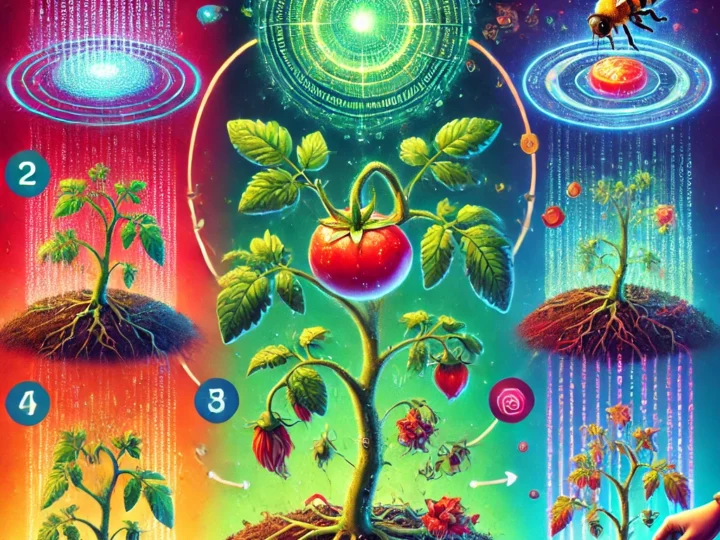When To Bee, and When Not To Bee
English is such a fun language because sometimes you stumble on hidden truths in cliches and every day phrases.
I recently discovered a new way of talking about the transition from Web 2.0 to Web 3.0 that Jack Conte, the founder of Patreon, so elegantly and passionately discussed at SXSW 2024. (youtube link). The core idea is that we are using Moth platforms, and they are slowly becoming Bee platforms as we build tools that give us the right to remix. There is so much nuance in the difference between a follower and subscriber, and it may be the easiest way to think about one of the most important things humanity seems to building this year: AI we actually enjoy using, that credits and pays creators, that can be relied on to get real work done without supervision. I’ll explain, but first, some context.
One of the people I follow on twitter, Amanda Goetz, recently posted about how moths fly toward a light, but bees dance with flowers, and challenged her followers to think about who they’re “mothing towards” vs. “beeing with”
Stop confusing moths with bees.
Moths see a bright light and they fly toward it. Moths don’t care what is giving off the light. When the light goes out, the moths leave.
Bees see a bright flower and want to coexist with it. They cross pollinate and add to the existence of the…
— Amanda Goetz (@AmandaMGoetz) August 22, 2024
Stop confusing moths with bees.
Moths see a bright light and they fly toward it. Moths don’t care what is giving off the light. When the light goes out, the moths leave.
Bees see a bright flower and want to coexist with it. They cross pollinate and add to the existence of the flower.
Stop confusing the people in your life for bees if they are really just moths.
— Amanda Goetz (@AmandaMGoetz) August 22, 2024
And the phrase “To bee or not to bee” came to mind for me.

I think bees and moths are actually a beautiful metaphor not just for how we relate to each other interpersonally online and off, but also on a broader scale for how we use social media and interact with our mutuals and friends. And thinking about platforms as “Moth” platforms (strictly creation, where posts can only be shared or deleted) vs. “Bee” platforms, where it’s easy to make a tiktok edit (jules terpak youtube link), remix, retweet, share-alike, send to a group chat, etc.
This is something I’ve been thinking at great length about lately as I attempt to build a new kind of group chat platform (heydata.org) where people can get real work done asynchronously together.
If we want to make great art, I think the bee metaphor can teach us a lot about the Right to Remix. I promise this will make sense, me out.
Bee-ing as a fractal pattern of both integration and separation
The final key to writing this post came to me from my YouTube algorithm.
I saw this YouTube video come across my feed today about how life is a state of being able to both DO and BE.
Your true nature IS experiencing separation. (emphasis added)
— Collette Barnes Whiteman September 14, 2024
And as I integrated and meditated on those concepts the last week or two, I kept thinking “I should really write something about this.”
The way that video opens, the first couple phrases, really get at the heart of the issue in a useful way I think.
Awakening is about realizing you are separate from some things, and in another way, you are one with all things. It’s about separation AND integration, rather than one or the other.

Life is about doing both integration and separation.
Life is about being both integrated and separate.
Life is about both doing and being, both. And knowing when to bee with your friends, and when to moth toward your purpose.
Life is about finding a principle worth working towards, and inviting others to work towards that principle with you.
It’s about finding groups of people that are already working toward your ideals or principles and asking to work together.
The fact that life often calls for switching between modes of doing and being is of great interest to people who want to live in harmony with those around them.
Doing and Being can be vague, it’s often more useful to use terms like engineering and innovation, and there’s a beautiful paper Bell Labs published in 1962 about switching between the two modes.
Here's a great example of shuttling between theory and practice, in one lab, by the same researchers, pursuing one goal (the transistor): https://t.co/suxrH7RY63
— Jason Crawford (@jasoncrawford) July 15, 2024
There is a time to think, and a time to act.
And that is the difference between flying like a moth around your purpose, and dancing like a bee among many higher principles worth working toward together.
Friendship As Forms Of Integrated Separation
Some of the best friendships you can have in life are with the people you don’t talk to on a regular basis, but you know that they would be there like family if you called.
You can pick up right where you left off, and whether it’s good news or bad news on the line when they pick up the phone, they’ll always make time if you both understand it’s important.

These are people you’re “beeing” with. There’s another familiar cliche, “If it’s meant for you, it will come back to you”
And this speaks both to friendships, and to the true depth of many things that in English we use only one word for: “love.”
Love is comfortable with separation, love is a structure that holds deep trust and confidence knowing that even separation is another way of “bee”ing together.
And in fact it’s when love does not agree to separation that it becomes something else: obsession.

There’s an idea around loving your work that I’m trying to write about, but it’s hard to write directly about without negative associations with obsession coming to mind, so let’s pivot.
I think the metaphor of Bee-ing and Moth-ing is actually more useful if instead of thinking about relationships, we think about social media posts.
I could write a long piece about how the subjects of photographs are made into legal objects, but I think that would miss my point for most people.
That makes sense for me, a photographer, but it may not make sense for other people.
Everyone who is not a photographer is more familiar with the idea that once you make a social media post, it becomes a legal entity, and you have certain rights to and licenses over it.
You remember in 2011 or whatever there would be those viral Facebook posts where people would write statuses in all caps that said “I DO NOT GIVE FACEBOOK LICENSE TO USE MY IMAGES OF ME AND MY FRIENDS” or whatever?
Yeah. That’s what happens when people are trying to understand licensing.
Licensing, in the way I’m imagining it in this post, is the power to freely switch from doing to beeing and have that work. An effective license is a legal tool to determine the kinds of control you maintain over parts of your body of work.
So let’s carry our “Moth and Bee” metaphor over to intellectual property land for a bit and see what we learn.
Love is trusting that revocation will be safe and effective
I’m going to talk about the negative associations that come up with “moth”ing by pivoting our metaphors from metaphors about relationships to instead metaphors about posting on social media.

So let’s think about the selfies that we post on social media for a moment.
I often describe myself as a photographer (even though I’ve been more into software development lately).
I do this because it is a SUPER useful frame for metaphors I make often, and if people see me as a photographer, it makes it easier to get the visual metaphors I use habitually.
As a photographer I am often challenged with the difficulty of licensing. I’ve run a stock photo service for about a decade, and one of the trickier parts is licensing people’s images for commercial use.
When I first got started, I made a mobile friendly online form where people could fill out a commercial image license if they happened to want to be the subject of a given image as I was out taking pictures of events or landscapes.
That way, they could easily fill something out on their phones, and then later in their inbox they’d be able to see how the picture turned out and how and where it was used.
Creation & licensing as acts of severance from yourself
People don’t necessarily think of posting a selfie as being the same thing as Taylor Swift releasing a song, but it is.

Many talented writers have written about how publishing is a small form of death. Many authors, directors, and songwriters talk about how once the work is made, it becomes (in a very significant way) property of the audience.
In many ways the “real meaning” of an art work is not what the author intended, but instead how the world receives it.
The license for a given work is similar, once the artist licenses a work, the world can receive it in a new way.
So hold this idea of the license you grant for your selfies for a moment. We’ll come back to it.
Let’s talk about attention.
AI Is Unlimited Free Attention
I’ve written before about how limited human attention is the safety valve for bad art. (Link to my Medium post called “Why I don’t worry about Trump or the sudden rise of click bait headlines” that’s not in any way as political as the title sounds).
TL:DR: We just ignore stuff that’s not that good, or where the author made a glaring error or mistake. That way, it goes away and doesn’t go viral. It is possible to delete bad art.
But it’s not possible to delete art that has grown wings. It is only possible to modify the license or re-create a new version of it.
Great art demands remixing or re-creation rather than revocation. Think of Taylor Swift’s music catalog.
If we’re entering a world with unlimited digital attention quite fast, we’re all about to encounter small versions of the Taylor Swift Music Catalog Problem as companies train Ai on our intellectual property. What will we be able to delete once the AI has been trained on it?
So it’s useful to think about how our systems can change to accommodate that and make it more comfortable for artists and poasters.
In a world of unlimited free attention (“moth”ing) how do we ensure it’s still safe to “Bee” freely?
Thoughtful licensing as the tool which turns lights into flowers
In a world of unlimited free AI attention with tools helping us answer our emails and find lost projects in our documents folder (as we’re already seeing), Artists will tend gradually to prefer publishing their work in a place where it’s safe and effective to disown it or even delete it, like Patreon.
We already have words for this of course.

Disowning your work is called Open Sourcing it (with various licenses you might use to do this, among them MIT or Creative Commons), or you can even choose to place your work in the public domain.
Public domain represents fully “disowning” a work, in a positive literal sense.
One of the most noticeable things about our social-media-first world today with constantly updating terms of service is that it’s possible to accidentally disown something.
You can easily lose control of parts of your work when they go viral.
You can make something and post it on social media, and it gets a life of its own, so to speak.

There are some things you can post that can never be revoked. And if you’re really lucky, talented, or (in some cases) unlucky, there are things that you can post that the world makes sure will never be forgotten.
Deleting your work doesn’t yet have an effective one-to-many equivalent. Many have commented on how the rise of the screenshot makes true revokation effectively impossible.
But it’s not impossible — already, instagram is beginning to credit the “original poster” of a creative work, so you could imagine they might do the inverse too.
Farther down that path is true revocation or effective remixing & overwriting of the license you granted a work when you published it.
Taylor Swift re-publishing her entire catalog was the first great concrete example of this effect at scale, and I hope many social platforms will allow long-term remixing, editing & re-writing features eventually, too. This is what I mean when I refer to the Right to Remix.
As creators, will we build a world where we always maintain the right to remix our own work?
Perhaps the new feature we get in the world of AI is not exactly revocation as it was clearly defined in the world of papers and libraries, but it’s closer to it.
Art is always a process of remixing, but as we continue to build new tools that allow not just remixing, but disowning and revoking, too, we’ll get better art.
What if we could build systems that allow for forgetting as a form of revocation?
Revocation of license as a change from spring to winter
What if you could find the images of yourself on the internet, and revoke licenses to their use, and have that actually work?
Adobe & Apple are already hard at work on the groundwork for a system like this through systems like the Content Authenticity Initiative that will build digital provenance systems into cameras and AI tools (complete with open source SDK!), and there are startups like Created By Humans (link to their landing page) working on it, too.
A deleted threads or twitter (x) post is a hint at this future and how it could work. You can no longer comment, retweet, share, or reply to the original idea, and so in a very useful way the idea is de-boosted.

We can continue to build more nuanced, thoughtful, and caring algorithmic improvements to that kind of revocation and re-authorship in the future.
And I expect Lander Gallery & DATA (the things I’ve been building lately) will be useful interfaces for interacting with that licensing groundwork.
Hopefully many more apps and devices will join in that mission too over the coming years.
Leaving Your Work Behind
Is a license of unlimited, global release in perpetuity the ultimate way of hitting publish?
Or is the right to remix the ultimate goal of making great work?
Is the ultimate goal of deeplying beeing about how bees leave flowers and head back to the hive all the time, or is it about how they go back to the hive to do a little dance and invite other bees to come with them on a great adventure back to the flowers?
When you are Beeing, it’s easy to let go of an idea and know that future revocation or remixes will be safe and effective.
Real friendship can go years without checking in, and know that there is still trust.

And if we hope to maintain real friendships online and trust our posts to be genuinely self expression, we’d best build systems that allow for letting go and forgetting with grace, humility, and real effect.
By stumbling on the idea of “bee”ing with the people you love to work with, I hope I’ve planted a seed that will grow into a recognition that we have certain rights, including the right to remix.
We should insist on building systems that allow us to express those rights by revoking and changing our licenses to our ideas and our image when the occasion arises.
Giving people that kind of control over their creations is a useful and productive next step toward a better online world.
There are many obvious flaws with a new idea like this, but it’s a useful frame, I hope, to think about the complexity of the licenses we grant every day when we share selfies on social media.
And I hope you will join me in building a world where artists get credit and licensing control as a fundamental part of their online creations.
While it’s not immediately obvious how something like that can all work, I think we can look to nature for useful patterns about how we can harmonize changes in the seasons.
Thanks for pollinating this idea with me. Feel free to share.





